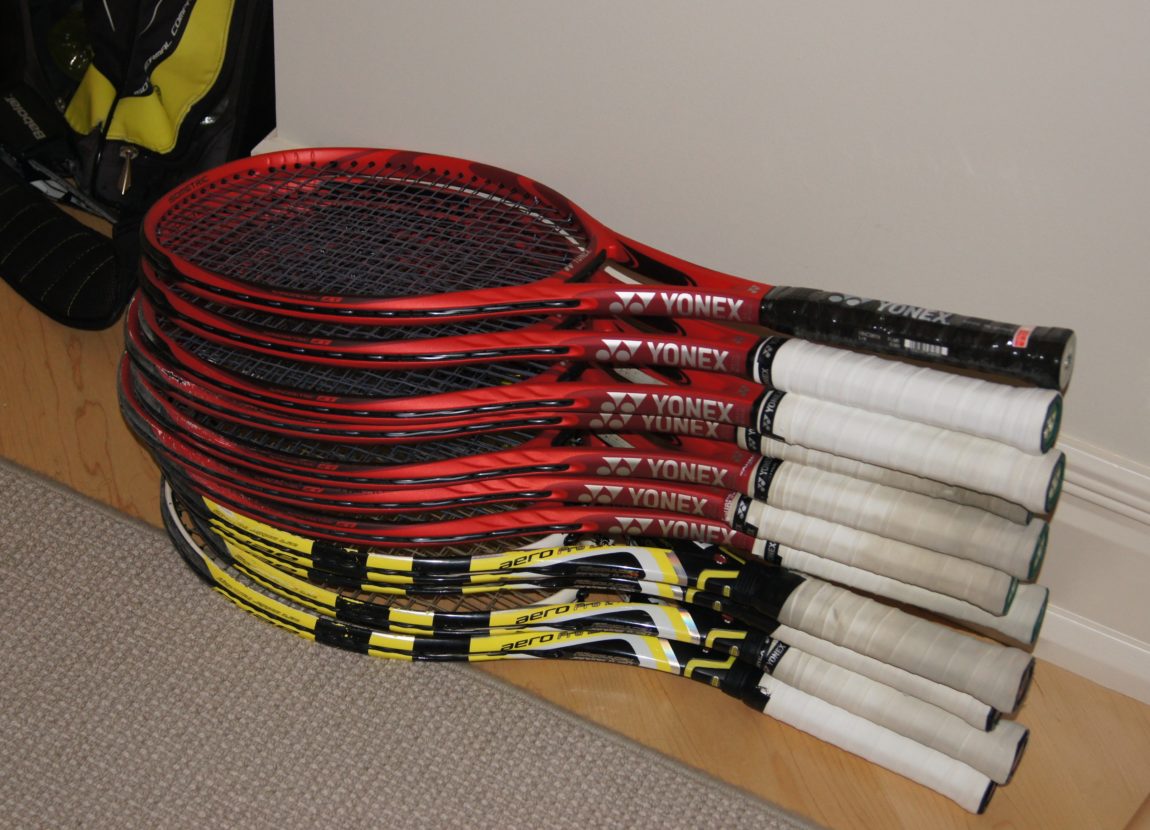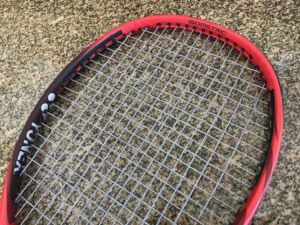Updated August 26, 2021
I have immersed myself completely in the world of tennis this past year, and, during that time, I learned a lot of useful pro tennis racquet tips. I have had numerous conversations regarding racquets with: tennis shop owners; tennis club pros; academy instructors; and kids and adults training and competing at the college level and above. I have spent numerous hours online researching racquet equipment options and the racquet preferences of touring professionals. Most importantly, I have experimented with a myriad of tennis racquet related equipment, anything that I thought could give me an edge, because, after all, I only have one chance at this tennis journey and I have to make the most of it.
I have compiled the below list of pro tennis racquet tips based on my conversations, research, and personal experience; although my tips may sound basic to college/tour players, I hope they prove useful to all the other tennis players out there with the dream of raising their game to the next level.
#1 – Do not settle for the tennis pro’s string recommendation. Experiment with a few different strings. It is worth it.
Besides the professionals, no one uses natural gut strings anymore because they are expensive and not durable. Synthetic gut or multifilament string is good for intermediate players. If you believe you are capable of generating significant acceleration and hit a heavier ball, try polyester “poly” string or a combination of poly and synthetic gut or poly and multifilament. Poly strings are more durable than synthetic gut or multifilament strings, but they lose tension more quickly. Additionally, poly strings can be tougher on your arm, so if you have arm or elbow issues please be careful.
I tried the following popular tennis strings, eventually selecting Solinco Tour Bite 17 gauge string:
- Wilson NXT
- Dunlop Synthetic S-Gut
- Gamma TNT2
- Babolat RPM Blast
- Luxilon Big Banger ALU Power
- Luxilon Big Banger ALU Power on mains and Gamma TNT2 on the crosses
- Solinco Tour Bite
The following website is one of my favorite string websites; it shows which strings and tensions the professionals play with.
Visit this website if you want to learn more about different string types.
#2 – Purchase a reel of string.
A typical reel of string has enough string for 16-17 racquets. So, if you replace your strings 4+ times a year, and you plan to stick with your string type for the next 3-4 years, buy a reel. A reel is the way to go, because you:
- Get what you want. You do not have to rely on the tennis shop having your string in stock. And, the tennis shop cannot slip up by stringing with the incorrect string.
- Don’t waste precious time. You do not have to waste your time looking among the aisles for your string or a suitable substitute.
- Save $$$. How much money will you save with a reel? It depends on the type of string, whether your tennis shop has a reel of your string, and how much the tennis shop marks up the string relative to prices available to you on the internet. For example, Wilson NXT 16 gauge string is typically sold in brick and mortar tennis shops by the packet. Assuming the shop marks up the packet 10% versus the price available on the internet, buying a reel of NXT 16 gauge online at Tennis Warehouse will save you ~5 USD every single racquet you get restrung at the shop! These are conservative assumptions; assuming 17 racquets can be strung with a reel and the mark-up is 20%, you would save 7-8 USD per racquet!
- Don’t break your strings often? I still recommend restringing your racquet as the strings definitely lose tension and pop over time. A fresh restring can make a world of difference. If you play once a week, you should get your racquet strung at least once per year. Play 2 times a week, get it strung at least 2x per year. Play 3 times a week, get it strung 3x per year and so forth… you get the picture.
I break the strings on my racquet twice a week, minimum. So, in my case, buying a reel has become a no brainer.

#3 – I typically see tensions ranging between 48 – 58 lbs., but string type has a lot to do with it. Experiment.
String tension is all about preference. Players using polyester strings often select less tension (approximately 50 lbs.). This allows them to “catch” the ball more and generate a heavier ball with more spin. Players using synthetic or multifilament strings typically select a slightly higher tension.
Higher tension means less power and more control (but less spin). Lower tension means more power and less control (but more spin). But, don’t increase the tension simply because you want to swing hard without worrying about the ball going out. Instead, learn how to hit with more top-spin.
I currently use Solinco Tour Bite, a poly string, at 51 lbs. of tension. I have experimented using 50, 51, 52, and 53 lbs. of tension. Poly strings lose tension quickly, so if I do not plan on hitting for 2+ weeks, I will request my racquet to be strung at a tension of one or two pounds higher than I prefer playing with.
#4 – If you play more than 1X or 2X a week, I would strongly recommend using an overgrip rather than a replacement tennis grip. Below I discuss my favorite overgrips.
I’m a big believer that a fresh grip is critical. Not only do new grips prevent slippage, but the comfort gives me more confidence on court. Overgrips can be applied more quickly than replacement grips and at a fraction of the price. Although overgrips may only last a few sessions before a change is required, the price point makes it well worth it. Overgrips are typically sold in packages of 3, 12, or 30: each grip costs 1-2 USD.
My favorite overgip is the Yonex Super Grap Overgrip, because it is tacky, comfortable, and lasts longer than other overgrips. That being said, it is slightly thicker than the Wilson Pro Overgrip, which is another fantastic grip. If it is extremely hot or humid, and it is difficult to hold onto the racquet with sweaty hands, I would recommend the Tourna Grip XL Original Dry Feel Overgrip. The Tourna Grip is the most popular grip I encountered while training at tennis academies and playing in the Open level tournaments.
**Be careful changing grips after your hand has grown accustomed to a certain type of grip. For example, if you are swapping out a softer comfortable grip for the Tourna Grip XL Original Dry Feel Overgrip, there is a high probability that you will develop a blister. From personal experience, I recommend slowly transitioning to the new grip. This is one of the pro tennis racquet tips I would not overlook!
Recently, I experimented by using a leather replacement grip on my racquet. Many of the players on the tour prefer to use a leather grip, because it enables them to feel the bevels of the racquet grip. After a few sessions on the court, I noticed that the leather grip was making the handle heavier than the frame. I found out that the leather grip weighed 8.0 grams more than the synthetic grip that I had been using previously. I tried to counteract this by adding lead tape to the frame. FYI: The Yonex Super Grap Overgrip weighs 5.5 grams.
**Leather grips can be a little rough on your hand and can tear the skin and create blisters if you are not constantly playing and developing thick calluses.
#5 – Do not be afraid to buy a racquet with a slightly smaller grip.
You can always build up the grip and make it larger by choosing larger replacement grips and overgrips. I made the mistake of trying out racquets that were all one size, before making a purchase. Down the road I realized that I had made a mistake, and a smaller grip was the appropriate route for me. This may explain why there are so many racquets in the above picture…
Check out the following video from Tennis Warehouse which demonstrates different methods for increasing the size of your tennis grip
#6 – This may seem a bit fancy, but experiment with lead tape to add weight to your tennis racquet. Lead tape can be a game changer.
The elite players play with racquets weighing more than 340 grams (strung, including grip). One instructor often reminds me “Force = Mass x Acceleration”. His point being, a heavier racquet will result in more force on the ball. While I agree, and was impressed that he was quoting Isaac Newton’s second law of motion, I counter that the racquet can be too heavy for you and it can negatively impact your acceleration or hurt your arm or elbow. It is important to find a weight that works for you.
Some players add weight to the handle, while others add lead tape to different parts of the racquet frame. Personally, I prefer a racquet that is a little frame heavy, so that it forces me to use my wrist and lead with the frame at and after contact. Some players believe adding a little weight to the frame will take some pressure off your shoulder, specifically while serving. After experimenting with different weights, I have lately been adding 4-5 grams of additional weight to the top portion of my frame.
I have tried lead tape from a few different manufacturers. My clear favorite is the SummerHouse Tennis Racquet Lead Tape. It is the best lead tape on the market. This tape adhesive is strong and will not fall off; it’s easy to cut to any size; and it has a unique black coating which prevents the lead from oxidizing. Many players have asked me where I purchased my lead tape from and I always recommend this brand.
**If you add weight to your racquet, make sure you do so gradually! Adding too much weight to your racquet too quickly will result in injury. At first, I added too much weight all at once and the heavier racquet began to bother my wrist. When I am playing less often, I make sure to only use small amounts of lead tape. This is one of my favorite pro tennis racquet tips!
I would love to hear about your experiences and/or opinion regarding my pro tennis racquet tips. Please comment below!
Disclaimer Regarding Affiliate Links
Article includes affiliate link(s). When a reader clicks one of these links and makes a purchase I receive a small commission, at NO cost to the reader. Anytime you click a link to my site and make a purchase please assume it is an affiliate link, and thank you for helping to support my blog. I only recommend products or services that I have used and strongly believe in their quality and usefulness. When you click on an affiliate link on my site you can rest assured that I have taken the time to thoroughly evaluate and consider the product before recommending it! Cheers.








